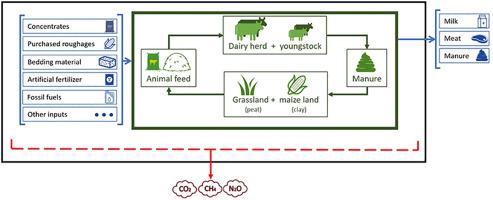Agricultural Systems ( IF 6.6 ) Pub Date : 2021-08-09 , DOI: 10.1016/j.agsy.2021.103243 Emma van Boxmeer 1 , Pablo Modernel 1 , Theo Viets 1

|
CONTEXT
Global demand for milk is increasing, however, the dairy sector has considerable environmental impact and cattle are large contributors to greenhouse gas (GHG) emissions that lead to global warming. In a circular food system, the role of animals should be to convert biomass that humans cannot or do not want to eat into nutrient-dense products. In this system, dairy cows are only fed with grass from marginal lands and by-products from harvesting and food industries. One example of marginal land are peat areas, since these soils are mainly too wet for arable crop production. However, drainage caused peat to oxidize and emit CO2 and N2O.
OBJECTIVE
The objective of this study was to evaluate global warming potential (GWP) and economic performance of Dutch dairy farms on peat compared to sandy soil. Also, two scenarios that might reduce GHG emissions of a dairy farm on peat soil were considered: 1) increased groundwater tables and 2) an adjusted dairy cow diet consisting of grass and by-products only.
METHODS
A whole-farm linear programming (LP) model used for dairy farms on sandy soil was updated and adjusted to simulate structure, management and labour income of a dairy farm on peat soil. The basic LP model is a static year model that includes all relevant activities and constraints that are common to a Dutch dairy farm and the solution generates feeding management, manure application and land use. The objective function maximized labour income. In addition, the linear model was combined with a Life-Cycle Assessment to determine the GWP of the produced milk, economically allocated between milk and meat.
RESULTS AND DISCUSSION
The results of this study showed that dairy farms on peat soil have lower labour income and considerably higher GWP compared to dairy farms on sandy soil. When the groundwater table on peat soil was increased, labour income decreased even more, however GHG emissions were somewhat reduced. Feeding a dairy cow diet with only grass and by-products resulted in higher labour income, but equal GWP compared to a regular dairy farm on peat soil. A sensitivity analysis was performed to explore the effect of grass yield on the economic and environmental performance of dairy farms on peat soil.
SIGNIFICANCE
Dairy farms on peat soils have lower labour income and considerably higher GWP compared to sandy soils. Improvement of GWP is possible and can lead to increased labour income.
中文翻译:

荷兰奶牛场在泥炭土上的环境和经济表现
语境
全球对牛奶的需求正在增加,然而,乳制品行业对环境产生了相当大的影响,而牛是导致全球变暖的温室气体 (GHG) 排放的主要贡献者。在循环食物系统中,动物的作用应该是将人类不能或不想吃的生物质转化为营养丰富的产品。在这个系统中,奶牛只吃来自边缘土地的草和收获和食品工业的副产品。泥炭地是边缘土地的一个例子,因为这些土壤主要是太湿而无法种植农作物。然而,排水导致泥炭氧化并排放 CO 2和 N 2 O。
客观的
本研究的目的是评估荷兰奶牛场在泥炭上与沙质土壤相比的全球变暖潜能值 (GWP) 和经济表现。此外,还考虑了可能减少泥炭土奶牛场温室气体排放的两种情况:1) 增加地下水位和 2) 调整后的奶牛饮食,仅由草和副产品组成。
方法
更新和调整了用于沙土奶牛场的全场线性规划 (LP) 模型,以模拟泥炭土奶牛场的结构、管理和劳动力收入。基本 LP 模型是一个静态年份模型,包括荷兰奶牛场常见的所有相关活动和约束,解决方案生成饲养管理、粪便施用和土地利用。目标函数使劳动收入最大化。此外,线性模型与生命周期评估相结合,以确定所生产牛奶的 GWP,在牛奶和肉类之间进行经济分配。
结果与讨论
这项研究的结果表明,与沙质土壤上的奶牛场相比,泥炭土上的奶牛场劳动收入较低,全球升温潜能值高得多。当泥炭地地下水位增加时,劳动收入减少更多,但温室气体排放量有所减少。仅用草和副产品喂养奶牛饮食会导致更高的劳动收入,但与泥炭土上的普通奶牛场相比,GWP 相等。进行了敏感性分析,以探讨草产量对泥炭土上奶牛场经济和环境绩效的影响。
意义
与沙质土壤相比,泥炭土壤上的奶牛场劳动收入较低,全球升温潜能值明显较高。GWP 的改善是可能的,并且可以导致劳动收入的增加。


























 京公网安备 11010802027423号
京公网安备 11010802027423号